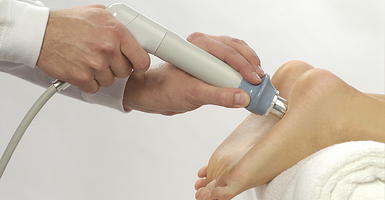Shockwave Therapy
What is it?
Shockwaves appear in the atmosphere when explosive events take place, such as lightning strikes and when aeroplanes break the sound barrier. Shockwaves are acoustic pulses that are characterised by high positive pressure amplitudes and a very steep increase in pressure in comparison to the ambient pressure. It has been around since the 1990’s and is used in urology to disintegrate kidney stones. It has been used by the Olympic teams to help reduce pain and restore function after their events. It is non-invasive and the patient can walk straight after the treatment.
How does it work?
The shockwave therapy utilises electrohydraulic, electromagnetic, and piezoelectric principles. (Ching-Jen Wang 2012) The primary effect is the direct mechanical forces that result in the maximal beneficial pulse energy concentrated at the target point where treatment is provided; and the secondary effect is the indirect mechanical forces by cavitation which may cause negative effect or damage to the tissues. (Wang 2012) The shockwave creates micro ruptures in the capillaries in tendon/ bone and significantly increases the growth indicators. Consequentially it stimulates the grow and remodelling of new arterioles and stimulates the regeneration of degenerated tissue, increases cell permeability, stimulates microcirculation (blood, lymph) and stimulates stem cells. (Dreusulker 2010)
What conditions can it treat?
Plantar fasciitis, plantar fasciosis, Achilles tendinopathy, medial tibial stress syndrome, patella tendinitis, posterior tibial stress syndrome, peroneal tendon irritation.
It can also be used to treat trigger points and muscle cramps.
How many treatments are required?
This will depend on the severity of the condition. Usually between 4- 6 treatments are required.
There may be an underlying biomechanical problem which may require the prescription of an orthotic.
What are the Contraindications?
Bleeding disorders or blood thinning medication
Children with unfused epiphyses
Cardiac Pacemakers
Local infections or malignancies
Pregnancy


